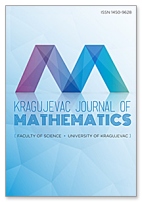Results on Tauberian Theorem for Cesàro Summable Double Sequences of Fuzzy Numbers
 Download PDF
Download PDF
Authors: B. B. JENA, S. K. PAIKRAY, P. PARIDA AND H. DUTTA
DOI: 10.46793/KgJMat2004.495J
Abstract:
The paper aims to establish new results on Tauberian theorem for Cesàro summability of double sequences of fuzzy numbers, and thus to extend and unify several results in the available literature. Further, a number of special cases, corollaries and illustrative example in support of the investigation of this paper are also presented.
Keywords:
Double Cesàro summability, slow oscillation, Tauberian condition, sequence of fuzzy numbers.
References:
[1] Y. Altın, M. Mursaleen and H. Altinok, Statistical summability (c, 1) for sequences of fuzzy real numbers and a tauberian theorem, Journal of Intelligent and Fuzzy Systems 21 (2010), 379–384.
[2] I. Çanak, Tauberian theorems for cesàro summability of sequences of fuzzy numbers, Journal of Intelligent and Fuzzy Systems 27 (2014), 937–942.
[3] H. Dutta, On some complete metric spaces of strongly summable sequences of fuzzy numbers, Rend. Semin. Mat. Univ. Politec. Torino 68 (2010), 29–36.
[4] H. Dutta, A characterization of the class of statistically pre-Cauchy double sequences of fuzzy numbers, Appl. Math. Inf. Sci. 7 (2013), 1433–1436.
[5] H. Dutta and F. Başar, A generalization of orlicz sequence spaces by cesàro mean of order one, Acta Math. Univ. Comenian. (N.S.) 80 (2011), 185–200.
[6] H. Dutta and T. Bilgin, Strongly (vλ,a,δvmn,p)-summable sequence spaces defined by an orlicz function, Appl. Math. Lett. 24 (2011), 1057–1062.
[7] B. B. Jena, S. K. Paikray and U. K. Misra, A tauberian theorem for double cesàro summability method, Int. J. Math. Math. Sci. 2016 (2016), 1–4.
[8] B. B. Jena, S. K. Paikray and U. K. Misra, Inclusion theorems on general convergence and statistical convergence of (l, 1, 1)-summability using generalized tauberian conditions, Tamsui Oxf. J. Inf. Math. Sci. 31 (2017), 101–115.
[9] K. Knopp, Limitierungs-umkehrsätze für doppelfolgen, Math. Z. 45 (1939), 573–589.
[10] M. Matloka, Sequences of fuzzy numbers, Busefal 28 (1986), 28–37.
[11] F. Móricz, Tauberian theroems for cesàro summable double sequences, Studia Math. 110 (1994), 83–96.
[12] S. Nanda, On sequences of fuzzy numbers, Fuzzy Sets and Systems 33 (1989), 123–126.
[13] P. V. Subrahmanyam, Cesàro summability of fuzzy real numbers, J. Anal. 7 (1999), 159–168.
[14] O. Talo and F. Başar, On the slowly decreasing sequences of fuzzy numbers, Abstr. Appl. Anal. 2013 (2013), 1–7, Article ID 891986.
[15] O. Talo and C. Çakan, On the cesàro convergence of sequences of fuzzy numbers, Appl. Math. Lett. 25 (2012), 676–681.
[16] B. C. Tripathy and S. Debnath, On generalized difference sequence spaces of fuzzy numbers, Acta Scientiarum Technology 35 (2013), 117–121.
[17] B. C. Tripathy, A. Baruah, M. Et and M. Gungor, On almost statistical convergence of new type of generalized difference sequence of fuzzy numbers, Iran. J. Sci. Technol. Trans. A Sci. 36 (2012), 147–155.
[18] Č. V. Stanojević, Analysis of divergence control and management of divergent process, in: İ. Çanak (Ed.), Graduate Research Seminar Lecture Notes, University of Missouri-Rolla, Fall, 1998.
[19] L. A. Zadeh, Fuzzy sets, Information and Control 8 (1965), 338–353.
